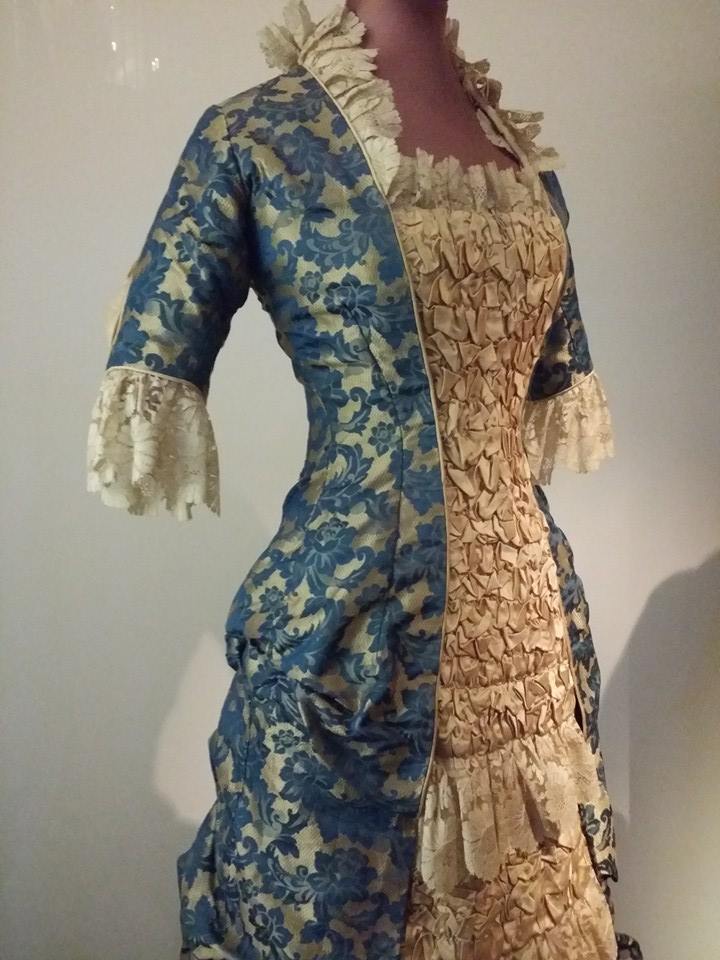Princess line on:
[Wikipedia]
[Google]
[Amazon]

 "Princess line" or "princess dress" describes a woman's fitted
"Princess line" or "princess dress" describes a woman's fitted

 "Princess line" or "princess dress" describes a woman's fitted
"Princess line" or "princess dress" describes a woman's fitted dress
A dress (also known as a frock or a gown) is a garment traditionally worn by women or girls consisting of a skirt with an attached bodice (or a matching bodice giving the effect of a one-piece garment). It consists of a top piece that co ...
or other garment cut in long panels without a horizontal join or separation at the waist. Instead of relying on darts
Darts or dart-throwing is a competitive sport in which two or more players bare-handedly throw small sharp-pointed missiles known as darts at a round target known as a dartboard.
Points can be scored by hitting specific marked areas of the bo ...
to shape the garment, the fit is achieved with long seams
Seam may refer to:
Science and technology
* Seam (geology), a stratum of coal or mineral that is economically viable; a bed or a distinct layer of vein of rock in other layers of rock
* Seam (metallurgy), a metalworking process the joins the end ...
("princess seams
Princess seams are long rounded seams sewn into women's blouses or shirts to add shaping or a tailored fit to closely follow a woman's shape. They are sewn into the front and/or back of a shirt, and extend from the waist up to the arms. Princess ...
") and shaped pattern pieces. A rarely used alternative name for the Princess line was ''French-dart-line dress''.
History
19th century
The princess line is popularly associated withCharles Frederick Worth
Charles Frederick Worth (13 October 1825 – 10 March 1895) was an English fashion designer who founded the House of Worth, one of the foremost fashion houses of the 19th and early 20th centuries. He is considered by many fashion historians to ...
who first introduced it in the early 1870s. It was named in honour of the famously elegant Princess Alexandra. By the late 1870s and early 1880s the Princess dress was a popular style. It is considered one of the first " bodycon" (body-conscious) fashions due to its extremely closely fitted design, presenting the figure in a natural (or at least, corset
A corset is a support garment commonly worn to hold and train the torso into a desired shape, traditionally a smaller waist or larger bottom, for aesthetic or medical purposes (either for the duration of wearing it or with a more lasting eff ...
ed) form undistorted by either crinoline
A crinoline is a stiff or structured petticoat designed to hold out a woman's skirt, popular at various times since the mid-19th century. Originally, crinoline described a stiff fabric made of horsehair ("crin") and cotton or linen which w ...
or bustle
A bustle is a padded undergarment used to add fullness, or support the drapery, at the back of women's dresses in the mid-to-late 19th century. Bustles are worn under the skirt in the back, just below the waist, to keep the skirt from dragging. ...
. 'Princess-line polonaises
The polonaise (, ; pl, polonez ) is a dance of Polish origin, one of the five Polish national dances in time. Its name is French for "Polish" adjective feminine/"Polish woman"/"girl". The original Polish name of the dance is Chodzony, meani ...
' were worn over long underskirts. The Princess line was also popular for young girls, who wore it with a sash
A sash is a large and usually colorful ribbon or band of material worn around the body, either draping from one shoulder to the opposing hip and back up, or else running around the waist. The sash around the waist may be worn in daily attire, bu ...
or, if slightly older, over a longer underskirt.
20th century
The Princess line was a staple of dress design and construction throughout the century. In 1951 the couturierChristian Dior
Christian Ernest Dior (; 21 January 1905 – 24 October 1957) was a French fashion designer, best known as the founder of one of the world's top fashion houses, Christian Dior SE, which is now owned by parent company LVMH. His fashion houses ...
presented a princess-line based fashion collection which is sometimes called the 'Princess Line,' although its official name was ''Ligne Longue'' or 'Long Line'.
21st century
The Princess line remains a popular style forwedding dress
A wedding dress or bridal gown is the dress worn by the bride during a wedding ceremony. The color, style and ceremonial importance of the gown can depend on the religion and culture of the wedding participants. In Western cultures and Anglo ...
es and a design staple for both day and evening dresses. More recently, the design principle has been consciously applied to men's garments, which generally do not have waist seams anyway.
See also
*Princess seams
Princess seams are long rounded seams sewn into women's blouses or shirts to add shaping or a tailored fit to closely follow a woman's shape. They are sewn into the front and/or back of a shirt, and extend from the waist up to the arms. Princess ...
References
19th-century fashion 20th-century fashion 21st-century fashion Dresses {{fashion-stub